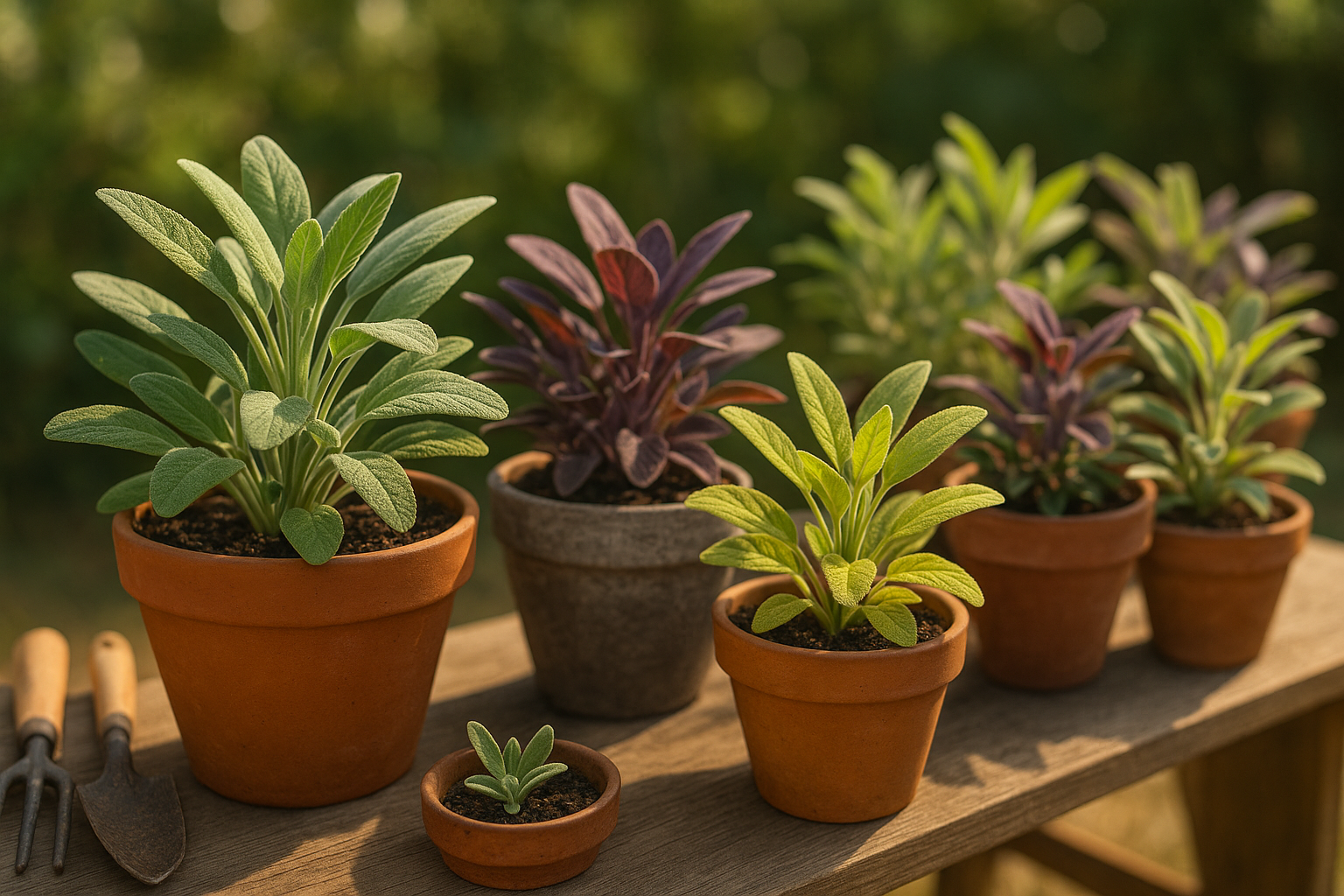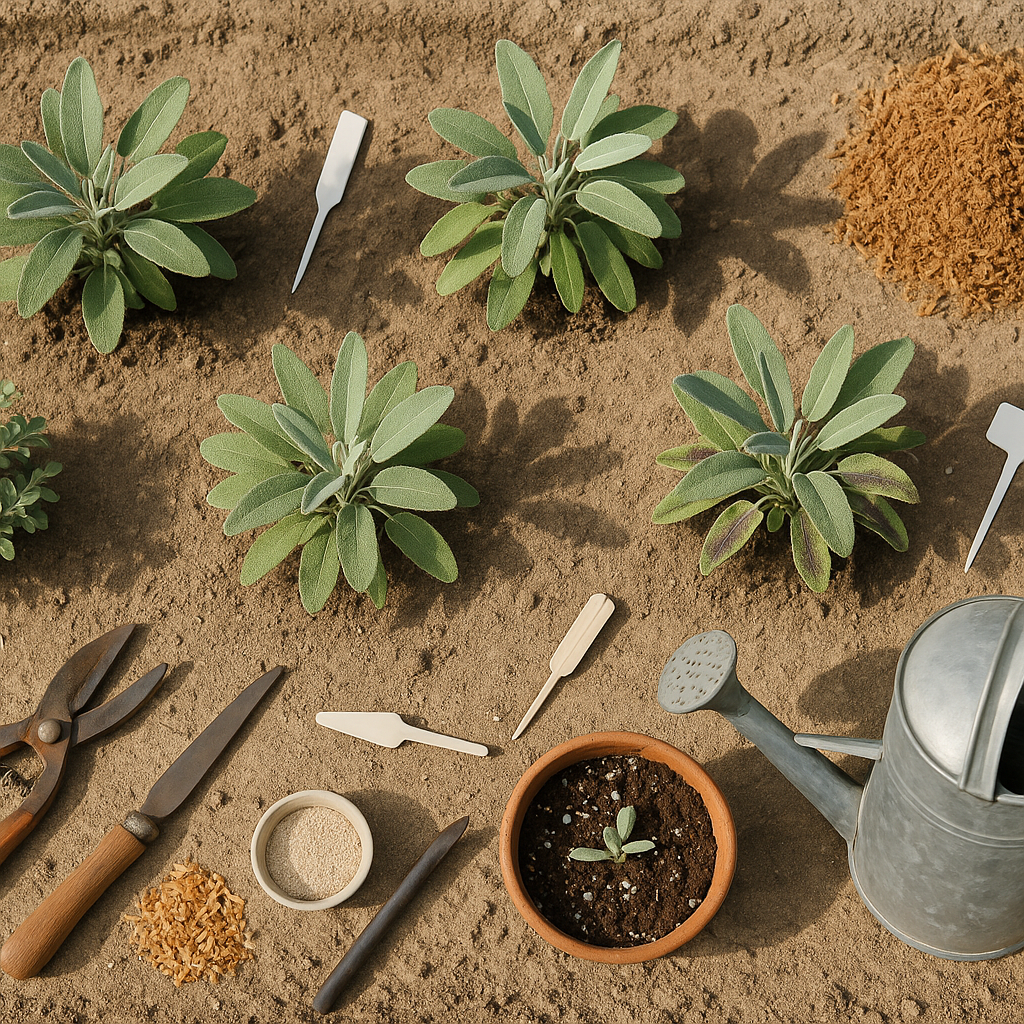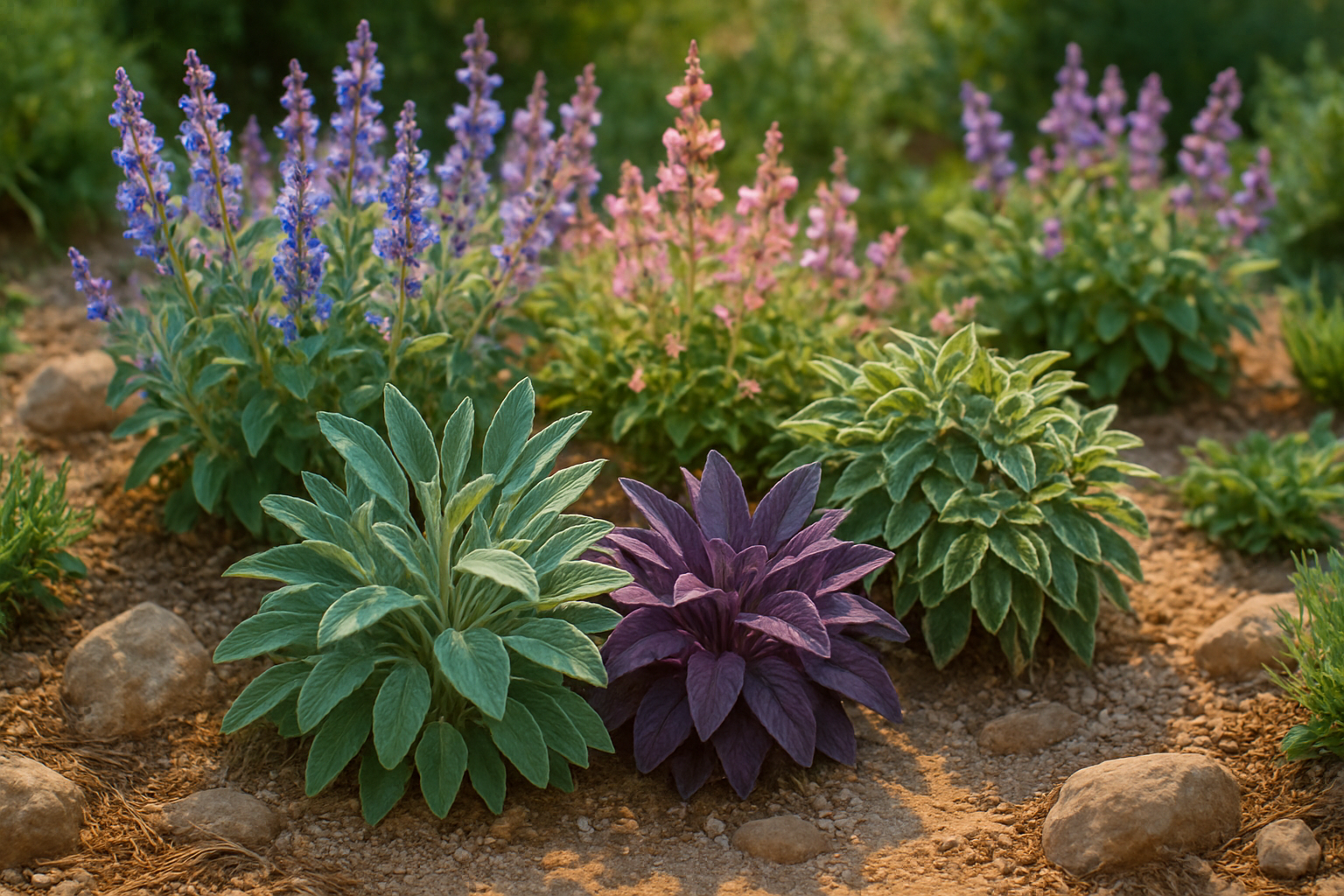Introduction to Sage and Its Benefits
When it comes to elevating your garden, kitchen, or even your home apothecary, exploring the best sage varieties can make all the difference. Sage (Salvia) is a hardy, aromatic herb native to the Mediterranean region, cherished for centuries for its silvery-green leaves and earthy flavor. Its resilience and easy-care nature have made it a favorite among gardeners and cooks around the world. But sage isn’t just one plant—there are dozens of varieties, each with unique colors, scents, and growing habits. Some thrive in small pots on a sunny windowsill, while others spill beautifully over garden beds, adding both aroma and texture.
Sage’s popularity stretches far beyond its reputation as a classic culinary herb for flavoring meats, vegetables, and stuffing. Many gardeners grow sage for its ornamental appeal: its velvety leaves and spikes of lavender, pink, or blue flowers can attract pollinators and brighten up borders. Meanwhile, herbalists appreciate sage for its traditional medicinal uses, which range from soothing sore throats to aiding digestion. Even in small spaces or busy lifestyles, there’s a sage variety suited for every need—whether you’re after a robust culinary staple like common garden sage, a vibrant purple variety for visual interest, or a type favored for smudge sticks and tea blends.
Choosing the best sage varieties for your home garden or kitchen means considering your space, style, and intentions. In the sections to follow, we’ll explore top picks for every need, plus tips for growing and enjoying these versatile plants—no matter your gardening experience.
Choosing the Right Sage for Your Needs

Selecting the perfect sage variety starts with knowing exactly what you want from your plants. If you’re after a robust flavor for cooking, classic garden or common sage (Salvia officinalis) is a go-to; its peppery, earthy leaves add depth to meats, vegetables, and stuffings. For more unusual tastes, try pineapple sage—its sweet, fruity scent pairs beautifully with teas or desserts.
If you’re planting for ornamental value, look for options like tricolor sage or purple sage, which offer eye-catching foliage that brightens up borders or containers. Fragrant sage varieties, such as clary sage or golden sage, are prized for their strong aroma, making them ideal for potpourri or simply delighting the senses in a sensory garden.
Those interested in herbal remedies often gravitate toward common sage or Greek sage for their traditional medicinal uses, such as soothing sore throats or aiding digestion.
Consider your local climate—a Mediterranean herb, most sages thrive in full sun and well-draining soil. If you have a shady or damp garden, container growing may be your best bet for keeping roots happy. Also, think about the space you have: some sages, like Russian sage, get quite large and need room to spread, while dwarf cultivars work well on patios or in small beds.
Maintenance is generally easy—most sages are drought-tolerant once established, but regular pruning keeps them bushy and extends their lifespan. Choose compact, slow-growing types if you want low-effort care, or more sprawling kinds for a wild, cottage-garden look.
By matching your choice of sage to your climate, available space, and whether you prioritize flavor, fragrance, aesthetics, or healing uses, you’ll end up with plants perfectly tailored to your garden and lifestyle.
Top Culinary Sage Varieties to Grow at Home
If you love cooking with fresh herbs, growing your own culinary sage at home can bring exciting flavors and aromas to your dishes. Among the popular varieties, Common Sage (Salvia officinalis) stands out with its silvery-green, slightly fuzzy leaves and strong, earthy taste featuring hints of pine and citrus. This classic herb is a staple in poultry seasoning, stuffing, roasted meats, and even savory breads.
Tricolor Sage adds a decorative twist—its leaves are splashed with creamy white, pink, and green. While its flavor is milder than Common Sage, it works wonderfully in herb butters, potatoes, and creamy pasta sauces. Plus, its colorful foliage makes a pretty garnish.
Purple Sage, true to its name, has striking deep purple leaves and a robust, peppery flavor. It’s perfect for seasoning sausages, stews, and roasted vegetables, and it looks beautiful both in garden beds and on your plate.
Greek Sage (Salvia fruticosa) features smaller, grey-green leaves and a slightly sweeter, more floral flavor, making it popular in Mediterranean dishes, especially with lamb, fish, and beans.
Growing Tips for Sage

- Choose a sunny spot with well-draining soil, as sage dislikes wet feet—adding sand or gravel to heavy soils helps.
- Regularly trim your plants to encourage bushiness and prevent flowering, which can cause the leaves’ flavor to fade.
- Sage thrives in containers too, making it ideal for patio gardens or small spaces—just ensure pots have good drainage holes.
With a little care and the right variety, you’ll enjoy a year-round supply of savory, aromatic leaves for all your favorite recipes.
Best Ornamental and Fragrant Sage Types
Among the most eye-catching ornamental sages, Mexican Bush Sage (Salvia leucantha) stands out with its fuzzy purple and white flower spikes that bloom from late summer into autumn. Its arching, silver-green stems create a soft, flowing look in mixed borders and attract hummingbirds and butterflies in droves.
Pineapple Sage (Salvia elegans) is another favorite, appreciated not just for its bright scarlet flowers that appear in late summer, but also for the sweet pineapple scent released when you brush its foliage. Plant it near patios or walkways and enjoy the fragrance every time you pass by.
Blue Salvia (Salvia farinacea), with its vibrant blue to violet spikes, offers reliable color in garden beds and containers. Its sturdy stems hold up through heat and drought, drawing bees and butterflies all season long.
Clary Sage (Salvia sclarea) impresses with tall stalks of pastel pink, blue, or lilac blooms, adding a whimsical texture to cottage gardens and herb beds. Its musky, herbal fragrance comes from both flowers and leaves and is cherished in aromatherapy and essential oil production.
All these sage types thrive with minimal fuss—just provide plenty of sunlight and well-drained soil. For the best garden impact, try grouping several together for a tapestry of colors and scents, making a living pollinator magnet while creating focal points that delight the senses through multiple seasons.
Essential Tips for Growing Sage at Home
Growing sage at home is both rewarding and straightforward with a little know-how. Sage thrives best in well-draining, sandy or loamy soil with a neutral to slightly alkaline pH—much like the dry Mediterranean hillsides it originally called home.
Choose a sunny spot that receives at least six hours of direct sunlight each day, as sage loves warmth and light for healthy growth and strong flavor. When planting, space sage plants about 18 to 24 inches apart to give their bushy foliage plenty of room to spread and allow airflow to prevent mildew.
Water established sage plants sparingly—only when the top inch of soil is dry. Overwatering can cause root rot, so let the roots dry out a bit between watering sessions. Regularly prune your sage by snipping stems just above leaf nodes; this encourages bushier growth and keeps your plant from becoming leggy.
Keep an eye out for common pests like aphids or spider mites, which you can often wash away with a strong spray of water or control using natural neem oil. Powdery mildew can develop if plants are crowded or overwatered, so good air circulation and moderate watering are essential.
If you’re short on garden space, sage grows wonderfully in containers—just make sure your pot has drainage holes and use a light potting mix blended with sand or perlite for better drainage. Container-grown plants may need more frequent watering than those planted in the ground, as pots dry out faster, but they’re much easier to bring indoors during a surprise frost.
In-ground sage can develop deeper roots and may survive winter better in milder regions. Whether you choose a tidy patio pot or dedicate a corner of your garden, sage is a hardy herb that will reward you year after year with minimal effort.
Creative Ways to Use and Display Sage
Sage is more than just a flavorful herb—it’s a versatile star in landscaping, too. For a stunning garden, try planting sage alongside contrasting foliage like silvery lamb’s ear and chartreuse sedum. This not only highlights sage’s textured, grey-green leaves but also provides visual interest all season.
In borders, use sage as a low, fragrant hedge around roses or lavender to create lovely color and scent combinations. As a focal point, try grouping several culinary sage varieties—like purple, tricolor, and golden—for a vibrant, edible display.
When it’s time to harvest, snip stems in the morning after the dew dries for the most intense flavor; don’t take more than a third of the plant at once. To dry leaves, bundle stems with twine and hang them upside down in a cool, airy spot, avoiding direct sunlight. Once crisp, store dried sage in airtight jars for use in roasts or teas.
Fresh sage can be minced into compound butter, tossed over roasted veggies, or fried whole as a tasty garnish. For a creative accent, tuck sage into mixed herb pots on a sunny patio, where its silvery leaves provide contrast to bright basil and chives.
Whether you’re designing a kitchen garden or adding texture to perennial beds, sage’s beauty and utility make it a fantastic addition—just be sure to give it plenty of sun and well-drained soil for healthiest, happiest plants.
Conclusion
Sage is an incredibly versatile herb, offering much more than the common culinary variety found in most kitchens. With dozens of species and cultivars, sage adds a rich tapestry of color, aroma, and texture to any home garden.
Whether you prefer the classic, velvety leaves of garden sage for roasting meats, the bold purple hues of purple sage as a border plant, or the delicate, pineapple-scented foliage of pineapple sage for fragrant teas, there’s truly a sage for every gardening style and culinary taste.
Don’t be afraid to experiment—grow a mix of sages to create an herb patch that delights both your senses and your dinner plate. Try adding unusual varieties for an extra splash of visual interest, or explore the fragrant possibilities by rubbing a leaf between your fingers as you stroll through the garden.
Each type has its own charm and unique uses, from ornamental flower spikes that attract pollinators to soothing teas made from fresh leaves. We’d love to hear about your experiences—do you have a favorite variety of sage or a creative way to use it in your home and kitchen? Share your stories or ask questions in the comments below—we’re here to help and inspire your sage-growing journey!
